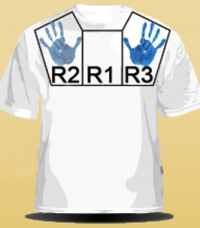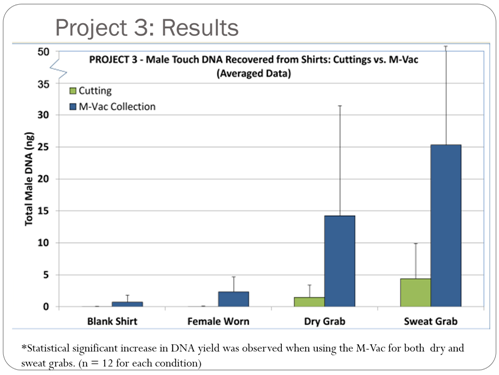
UC Davis - Cutting Comparison
Objective: Determine how much touch DNA the M-Vac™ can recover from cotton fabric compared to the common collection technique of cutting a small portion of the material. This study will help determine which method, M-Vac™ or cuttings, will yield the most touch DNA from fabric. Methods: Female volunteer wears a cotton shirt for 8 hours. Upper chest region of the shirt is divided into 3 regions, center, right and left. Male volunteer grabs region 2 for 45 seconds. Male volunteer runs until perspiring then grabs region 3 for 45 seconds. A cutting is taken from each region and each region is collected using the M-Vac™. Control collections were taken with both methods from the shirt prior to the experiment.
Methods: Female volunteer wears a cotton shirt for 8 hours. Upper chest region of the shirt is divided into 3 regions, center, right and left. Male volunteer grabs region 2 for 45 seconds. Male volunteer runs until perspiring then grabs region 3 for 45 seconds. A cutting is taken from each region and each region is collected using the M-Vac™. Control collections were taken with both methods from the shirt prior to the experiment.
Extraction/Analysis: Extract the DNA using the QIAmp® DNA Investigator Kit (Qiagen). DNA quantification was done with Quantifiler Duo® Kit (ABI). DNA amplification was done with AmpFISTER® Identifiler® PCR Kit and YSTR Kit (ABI).
Results: The M-Vac™ collected significantly more DNA material than was obtained through cutting with P values ranging from 0.0011 to 0.0079.

Conclusions: Touch DNA is typically not visible to the naked eye, even with the use of ALS (Alternative Light Source). Therefore, using a collection technique that only covers a small area can limit the DNA recovered. Cuttings are typically restricted to a 1 cm2 fragment, whereas the M-Vac™ can collect one sample from a much larger area. Compared to cuttings, the M-Vac™ collects more touch DNA because it is capable of covering a much larger surface area. In some trials, the cutting resulted in little or no DNA; however, the M-Vac™ is capable of collecting touch DNA. Regardless of the collection method used, more touch DNA is recovered if the contributor has sweaty hands.
References: 2014 AAFS Poster - Comparing the M-Vac to Standard DNA Collection Methods for Large Surface Areas, Katie L. Caswell; Marc J. Wander; Shane E. Williams; Ruth E. Ballard, Ph.D.; Cassandra D. Calloway, Ph.D.; Christopher J. Hopkins, M.S.; William M. Green, M.D.; Sree Kanthaswamy, Ph.D.; and Edward A. Panacek, M.D.; University of California at Davis, Forensic Science Program; Sacramento State University, California Clinical Forensic Medical Training Center.